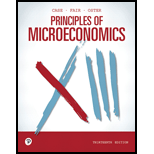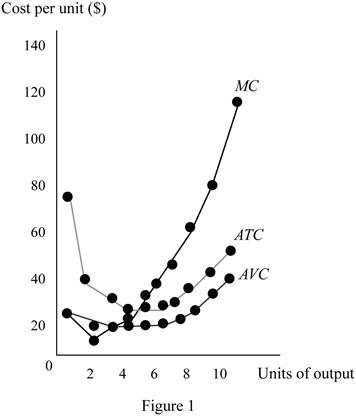
(a)
To complete the table.
(a)
Explanation of Solution
Since the total cost when the production is zero is $50, it is the total fixed cost. The total fixed cost is $50 and remains fixed through all the levels of production.
The total variable cost can be calculated using Equation (1) as follows:
Substitute the respective values in Equation (1) to calculate the total variable cost at output 1 unit.
The total variable cost of producing first unit of output is $20.
The
Substitute the respective values in Equation (2) to calculate the average variable cost at output 1 unit.
The average variable cost is $20.
The
Substitute the respective values in Equation (3) to calculate the average total cost at output 1 unit.
The average total cost is $70.
Marginal cost can be calculated using the following formula:
Substitute the respective values in Equation (2) to calculate the average total cost at quantity 1 unit.
The marginal cost of producing first unit is $20.
Table 1 shows the values of total fixed cost, total variable cost, average variable cost, average total cost, and marginal cost calculated using Equations (1), (2), (3), and (4).
Table 1
| Quantity of output | TC | TFC | TVC | AVC | ATC | MC |
| 0 | $50 | $50 | $0 | — | — | — |
| 1 | 70 | 50 | 20 | 20 | 70 | 20 |
| 2 | 80 | 50 | 30 | 15 | 40 | 10 |
| 3 | 90 | 50 | 40 | 13.3 | 30 | 10 |
| 4 | 110 | 50 | 60 | 15 | 27.5 | 20 |
| 5 | 140 | 50 | 90 | 18 | 28 | 30 |
| 6 | 175 | 50 | 125 | 20.8 | 29.2 | 35 |
| 7 | 220 | 50 | 170 | 24.3 | 31.4 | 45 |
| 8 | 280 | 50 | 230 | 28.8 | 35 | 60 |
| 9 | 360 | 50 | 310 | 34.4 | 40 | 80 |
| 10 | 450 | 50 | 400 | 40 | 45 | 90 |
Fixed cost: Fixed cost is defined as the cost that is independent of the level of output or production of a firm.
Variable cost: Variable cost is defined as the cost that depends on the level of production or output of a firm.
Marginal cost: Marginal cost is defined as the additional cost that is incurred due to the production of an extra unit of output.
Total cost: Total cost is defined as the sum of variable cost and fixed cost.
Average variable cost: Average variable cost is defined as the total variable cost divided by the quantity of output.
Average cost: Average cost is defined as the total cost divided by the quantity of output.
(b)
To graph the average variable cost curve, average total cost, and marginal cost curves.
(b)
Explanation of Solution
Figure 1 shows the cost curves of the given function.

The horizontal axis of Figure 1 measures the quantity of output, and the vertical axis measures the cost per unit. When the marginal cost is below the average variable cost curve or average total cost, the average variable cost curve and the average total cost curve also decrease. When the marginal cost rises above these costs, the average variable cost curve and average total cost curve increase. The marginal cost curve cuts both the average cost curve and the average variable cost curve from their minimum points.
Marginal cost: Marginal cost is defined as the additional cost that is incurred due to the production of an extra unit of output.
Average variable cost: Average variable cost is defined as the total variable cost divided by the quantity of output.
Average cost: Average cost is defined as the total cost divided by the quantity of output.
(c)
The output and profit produced by the firm in the short run when price is $20.
(c)
Explanation of Solution
When the price is $20, the maximum quantity of output that can be produced is 8 units. This is because the marginal cost of producing 8 units is equal to $20. When the 5th unit is produced, the marginal cost is higher than the price and hence the output is 4.
The total revenue can be calculated using Equation (5) as follows:
Substitute the respective values in Equation (5) to calculate the total revenue at quantity at 4 units.
The total revenue is $80.
The profit or loss can be calculated using Equation (6) as follows:
Substitute the respective values in Equation (6) to calculate the total profit/loss at quantity 4 units.
Thus, production of 4 units leads to a loss of $30.
Total revenue: Total revenue is defined as the total income earned from the output produced.
Total cost: Total cost is defined as the sum of fixed cost and variable cost.
Loss: Loss is defined as the excess cost incurred over the total revenue earned by the production.
(d)
The output and profit produced by the firm in the short run when price is $60.
(d)
Explanation of Solution
When the price is $60, the maximum quantity of output that can be produced is 4 units. This is because the marginal cost of producing 4 units is equal to $60. When the 9th unit is produced, the marginal cost is higher than the price, and hence the output is 8.
Substitute the respective values in Equation (5) to calculate the total revenue at quantity 8 units.
The total revenue is $480.
Substitute the respective values in Equation (6) to calculate the total profit/loss at quantity 8 units.
Thus, production of 8 units leads to a profit of $200.
Total revenue: Total revenue is defined as the total income earned from the output produced.
Total cost: Total cost is defined as the sum of fixed cost and variable cost.
Profit: Profit is defined as the excess revenue earned over the total cost by the firm.
Want to see more full solutions like this?
Chapter 8 Solutions
Principles Of Microeconomics

 Principles of Economics (12th Edition)EconomicsISBN:9780134078779Author:Karl E. Case, Ray C. Fair, Sharon E. OsterPublisher:PEARSON
Principles of Economics (12th Edition)EconomicsISBN:9780134078779Author:Karl E. Case, Ray C. Fair, Sharon E. OsterPublisher:PEARSON Engineering Economy (17th Edition)EconomicsISBN:9780134870069Author:William G. Sullivan, Elin M. Wicks, C. Patrick KoellingPublisher:PEARSON
Engineering Economy (17th Edition)EconomicsISBN:9780134870069Author:William G. Sullivan, Elin M. Wicks, C. Patrick KoellingPublisher:PEARSON Principles of Economics (MindTap Course List)EconomicsISBN:9781305585126Author:N. Gregory MankiwPublisher:Cengage Learning
Principles of Economics (MindTap Course List)EconomicsISBN:9781305585126Author:N. Gregory MankiwPublisher:Cengage Learning Managerial Economics: A Problem Solving ApproachEconomicsISBN:9781337106665Author:Luke M. Froeb, Brian T. McCann, Michael R. Ward, Mike ShorPublisher:Cengage Learning
Managerial Economics: A Problem Solving ApproachEconomicsISBN:9781337106665Author:Luke M. Froeb, Brian T. McCann, Michael R. Ward, Mike ShorPublisher:Cengage Learning Managerial Economics & Business Strategy (Mcgraw-...EconomicsISBN:9781259290619Author:Michael Baye, Jeff PrincePublisher:McGraw-Hill Education
Managerial Economics & Business Strategy (Mcgraw-...EconomicsISBN:9781259290619Author:Michael Baye, Jeff PrincePublisher:McGraw-Hill Education





